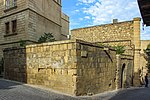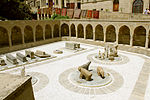Museum of Archaeology and Ethnography

The Museum of Archaeology and Ethnography is a museum in Baku, Azerbaijan, that was established in 1976. It bears the name of the Azerbaijani architect-Mikayil Huseynov. The museum has two parts. The ethnography section displays materials related to the 19th century and early 20th century, as well as the life of Azerbaijani people. The archaeology section exhibits findings covering all stages of Azerbaijani's historical development, its culture from the Stone Age to the late Middle Ages.The museum's exhibitions give detailed information about the sites of primitive people, living houses on the territory of Azerbaijan, settlements belonging to cattle breeders and farmers, historical and material culture of ancient states, gravestone monuments, Azerbaijani arts of ancient times, economy, lifestyle, moral values of ancestors of the Azerbaijani people.In 2008 the museum underwent restoration works and increased the number of its exhibitions to 2000.
Excerpt from the Wikipedia article Museum of Archaeology and Ethnography (License: CC BY-SA 3.0, Authors, Images).Museum of Archaeology and Ethnography
Aziz Aliyev street, Baku City
Geographical coordinates (GPS) Address Nearby Places Show on map
Geographical coordinates (GPS)
| Latitude | Longitude |
|---|---|
| N 40.3672 ° | E 49.8361 ° |
Address
İçəri şəhər
Aziz Aliyev street
1095 Baku City (Sabail Raion)
Baku, Azerbaijan
Open on Google Maps











